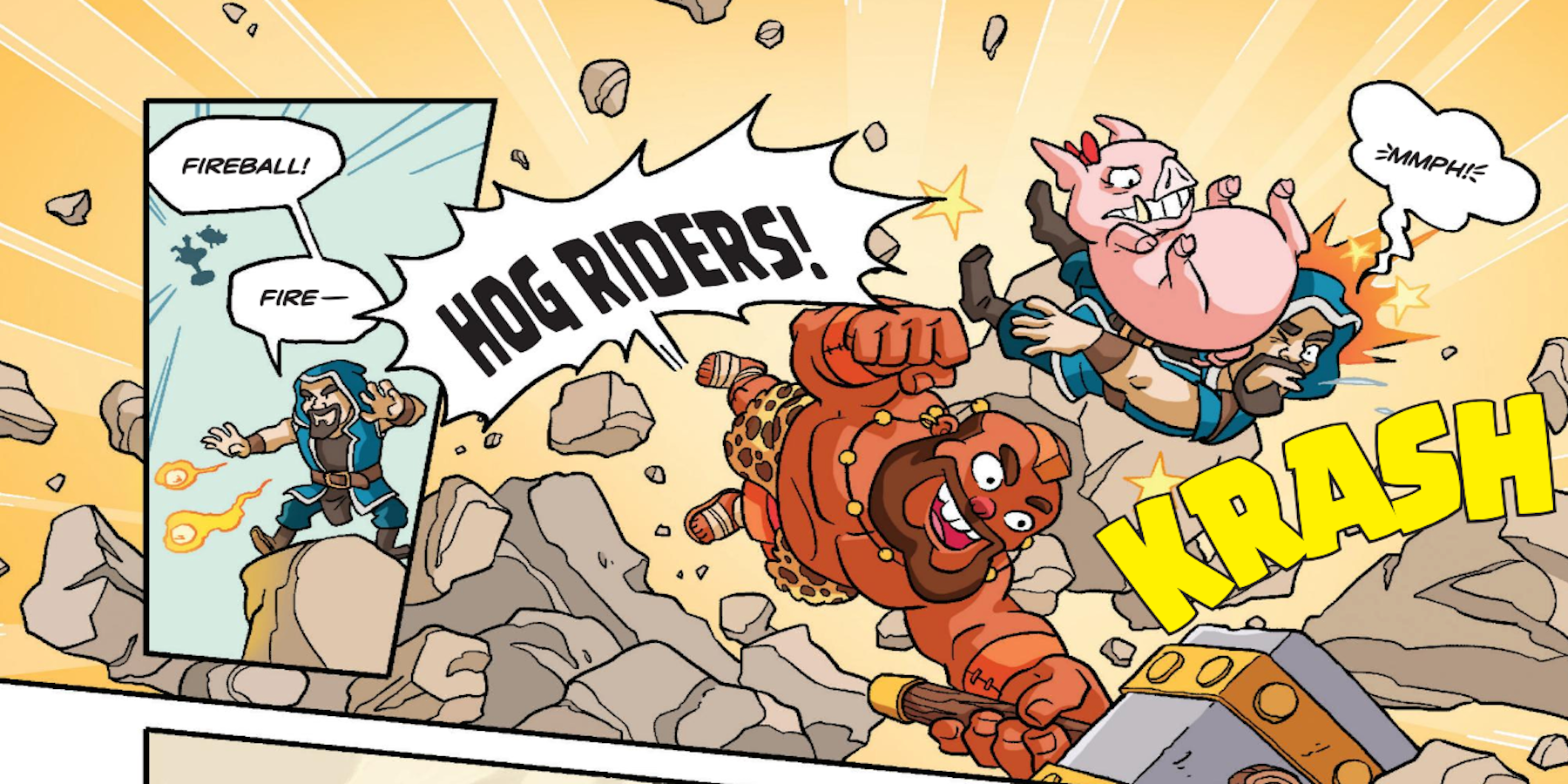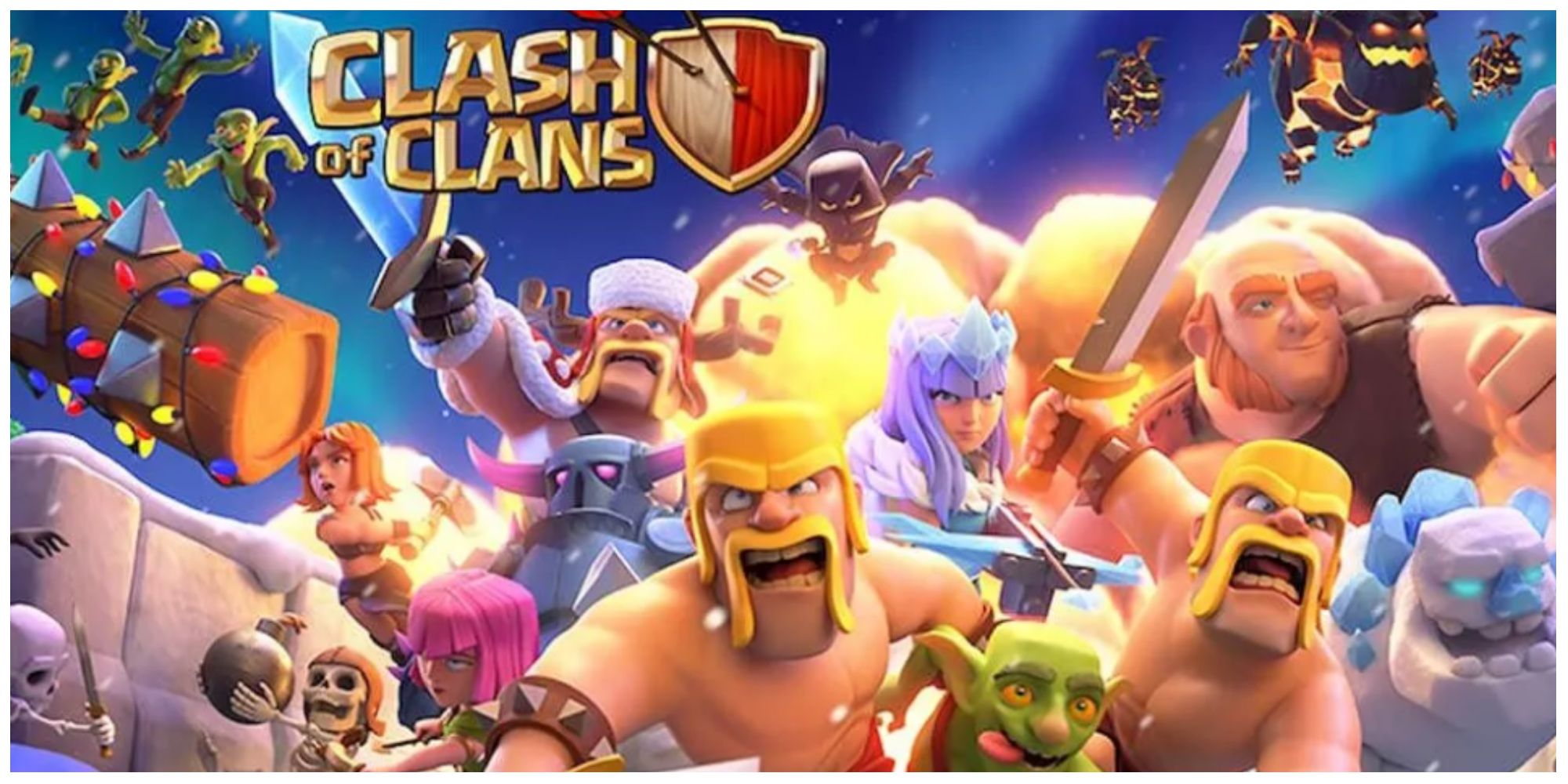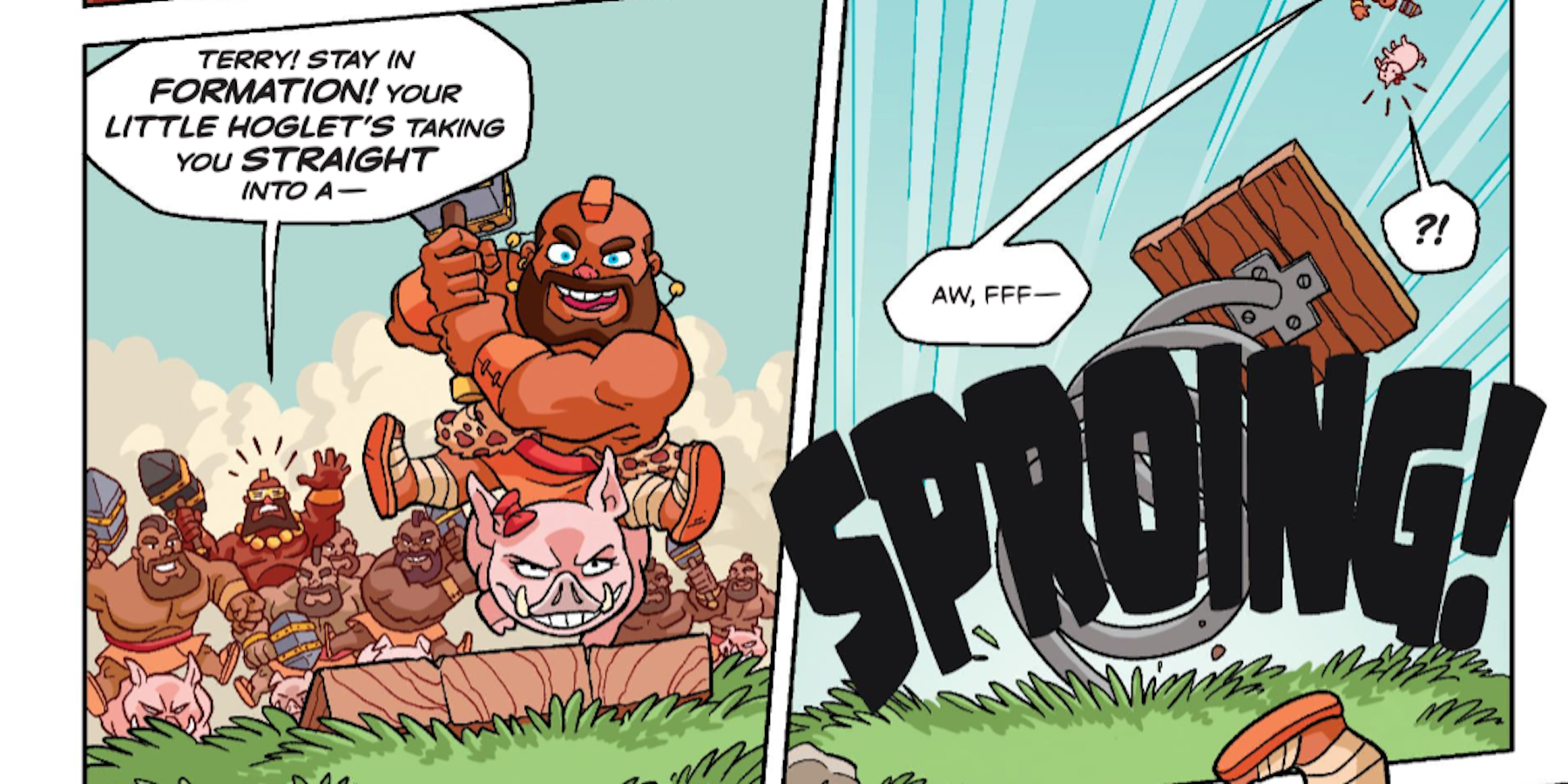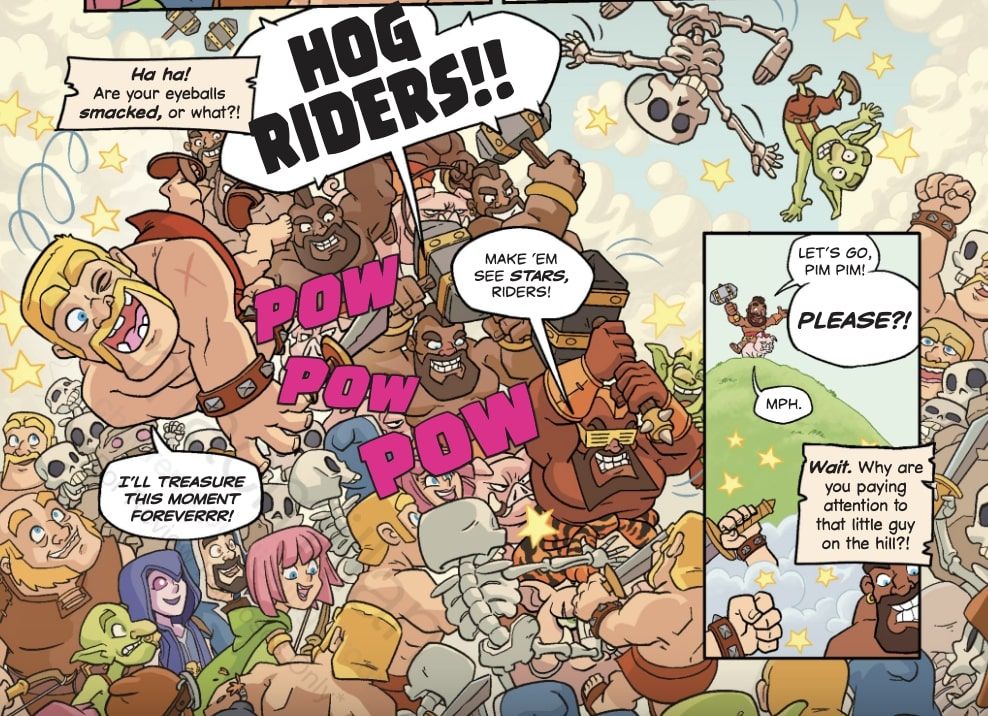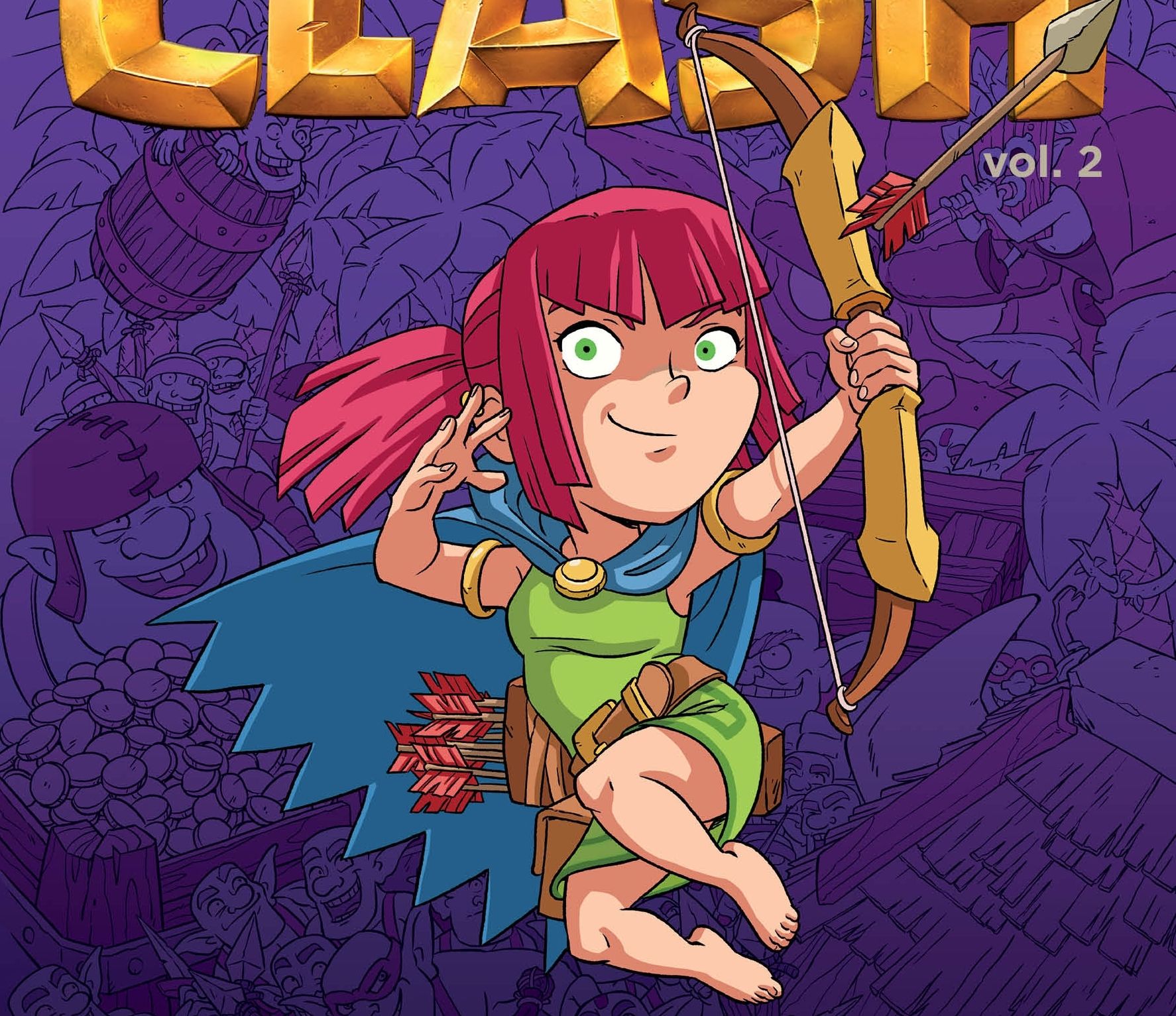Clash of Clans is extending its universe again, but this time with a graphic novel. The eight-volume series, Books of Clash, releaseds on May 30, with the first volume following the story of Hog Rider Terrodicus, or Terry, and his trusty hog, Pim Pim. Each book will focus on different characters from the Clash franchise like the Archers and Golems.
Books of Clash graphic novelist Gene Leun Yang talked with Game Rant in a recent interview about the goal to transition Clash players into readers and get to know the game's characters as an individual. The following transcript has been edited for clarity and brevity.
Q: For our readers, can you tell us a bit about yourself and Books of Clash?
Yang: My name is Gene Leun Yang. I'm a cartoonist, I write and draw comic books and graphic novels. I've been doing this for a very long time now, and I have some graphic novels where the stories, the characters, and the plots are my own. I also do stories in other people's universes. I did the first five Avatar: The Last Airbender graphic novels and I did those with an amazing art team called Gurihiru. I've done a bunch of work for DC mostly in their Superman group, and I did a 24-issue run on Shang Chi with Dike Ruan and Marcus To.
My most recent graphic novel series is Books of Clash, which I'm doing with First Second books. They're a publisher that I've worked with for a very long time, and we've teamed up with Supercell to do this. So these I wrote, and they're drawn by an art team made up of two incredibly talented artists Les McClaine and Alison Acton. So we're very excited.
Q: Clash of Clans and Clash Royale are two of the most downloaded mobile games ever. Were there any challenges in transforming that successful mobile game into a graphic novel?
Yang: There are lots of challenges. There are fun challenges, but there are still challenges. I first learned about Clash of Clans through my son, actually. He's 19 now, a sophomore in college, but when he was nine or 10 years old, he got introduced to this game. Then, he introduced it to my daughter, who's now 16, so she must have been like seven. They started playing it together. I also played with them a little bit, but I was never as good at them as they were. And then they got into a clan with the children of my editor, Mark Siegel, at First Second Books.
He has two kids around the same age as our two oldest. They're all in this clan together now. They live in New York and we live in California, so it was a way for these two families to bond over a video game, even though we're on two separate coasts. Ever since then, Mark and I have been talking about doing Clash books, but it didn’t work out. It's been like 10 years, and we've tried periodically all the way through until finally recently we had a meeting –I think this must have been 2020–we had a meeting with Supercell, and then we really got the ball rolling on this.
The biggest challenge in the game is it’s a very likable world. It's a world that you want to stay in. It's beautifully designed. The environments are gorgeous. The sound design is amazing, and the music is amazing. But the game is made up of these groups of troops, and every group, they all look the same. Like all the Hog Riders look the same. All the Archers look the same. All the Barbarians look the same. So when you're playing it, you're kind of like looking at this world from a God's eye view.
You don't see the characters as individuals, you see them as groups. It's hard to tell a story about a group of characters because stories are generally about individuals. They're about the interior lives of characters. What we want to do with this first volume, especially, is we actually want to move people from the player's eye view down to the reader's eye view, and you get to know individual characters.
The main character of our first book is Terry. He's a Hog Rider and you follow Terry as he actually gets into it. He moves to a new village, and he gets to know the people. And as he gets to know these other characters, he starts seeing them as individuals. In the beginning, one of his best friends ends up being an archer named Jane. Jane looks like all the other archers, but as he gets to know Jane, and as we get to know Jane, Jane starts to differentiate herself.
So that dynamic of individualization, I got from my own experience as a high school teacher. I was a high school teacher for 17 years. I remember being there on the first day of class, all of these students would come in, and they were just the mass of teenagers to me. But as the semester went on, as I got to know each individual, they became, ‘Oh, this is Sam, or this is Rodrigo, or this is Stacy.’ I would get to know them as individuals. We want that same dynamic to play out. That's how we deal with the fact that in the game, all the Hog Riders look the same and all the Archers look the same, and so on.
Q: In Clash of Clans and Clash Royale, they're known for their quirky characters who get into some chaotic action. Was it difficult incorporating some of these serious themes like family betrayal into the book?
Yang: I think I really love the quirkiness of the world that Supercell has built. It's a world that's made for in-jokes. It's a world that's kind of made to wink at you. There are all these little references that they built into the 80s because the creators of the games are these 80s kids. That's why the Hog Rider vaguely looks like Mr. T. That's why the Barbarian vaguely looks like Hulk Hogan. And that's also why when you see them party in commercials, they're often playing 80s-style heavy metal. All of that is really fun. I think in order for you to stick with the story for 120 pages and want to come back for more, you also have to get into some really deep human things. For this first volume, I wanted to explore the sibling relationship.
Part of that was inspired by my own kids who played the video game. They get along great now, but my son and my daughter, when they were younger, they didn't get along as well. Clash was one of the few ways that they actually interacted well together, so I've made a sibling relationship kind of the center of this first story. It's the story of Terry and his older brother, Rokkus, and [Terry] feels like he's always in his older brother's shadow and how he gets out of that shadow eventually.
Q: Can you describe Terry and his sidekick Pim Pim, and what does he or his journey symbolize thus far?
Yang: We signed up to do eight books, and every book is going to be focused on a different character. We start with Hog Riders, then we move on to Archers, then it's Golems, and then it's Valkyries, and then it's Goblins, and so on. We started with Hog Rider because it's essentially two characters. It's the rider and his hog. In a lot of ways when you have two characters at the center of your story, you can actually have a dialogue between them, and you can let your reader in on the dialogue. That dialogue actually is a window into the interior lives of these two characters. Pim Pim kind of functions like Terry's Jiminy Cricket – like his conscience, that's what we wanted.
We also wanted a very familial style of love between them, so they would die for each other. The rider and his hog would die for each other, but they still bicker like they’re family. That's what we really wanted. It was a lot of fun to write. Les McClaine, the artist, told me that his favorite part to draw was the hog. Later on, in volume four, we actually have a really hog-heavy story. I did that specifically for Les because we like drawing hogs [laughs].
Q: When Terry gets to Jazzypickleton, that new village, he constantly reiterates that this is not the “Hog Rider way” because there are different clans and they're all with each other. How does this realization affect his character development?
Yang: My editor Mark and I did have these discussions about what kind of stories would work best in the Clash world. In this world where there are these different troop types and all the individuals within that troop type all kind of look the same. I thought a lot about my experience going to college. I grew up in a small suburb of San Jose, and I went to UC Berkeley. Berkeley as a city is much more diverse than my town was. In a lot of ways, when you come from a small suburb, you have just one way of doing things. It’s hard for you to imagine another way of living, but then I remember going to UC Berkeley, and meeting all these different people who pursue life in all of these different ways.
And it really challenged the one way that I had in my head. I wanted Terry to go through something similar. He's coming from this environment where the only people he hangs out with are other Hog Riders. Then he goes into Jazzypickleton, which is a much more diverse village. For him, the Jazzypickleton is sort of like what UC Berkeley was for me. Then his one way of doing things gets challenged and he grows as a character because of that. So in the same way, I felt like being in Berkeley, I probably learned more from interacting with people who aren't like me than I did from the classes that I was taking.
Q: So Clash of Clans, the word clan is in there, and the word “clan” is a very exclusive word. Terry gets confronted by this very early on. I know you just referenced your going to college, but was there any other inspiration or references on how you could tackle this in the book?
Yang: College was definitely a big inspiration. Another one was getting into comics. My parents are immigrants, and like most immigrants, they had very specific ideas of what they wanted me to do for a living. They wanted me to be a doctor, a lawyer, or an engineer. A comic book creator, a graphic novelist was never on that list. When I got into the comics industry, in a lot of ways I was kind of turning away from the way that my parents wanted me to do things.
And in comics, I just met a lot of people who are very different from me. One of my best friends in the comic book industry dropped out of college, and he dropped out of college because he is an intensely talented artist. He just didn't need that degree to prove himself because he had such a strong portfolio. But that idea of dropping out of college, that would've been completely unthinkable in the community that I grew up in. Comics, I think, is just a very diverse community. I feel incredibly lucky to be a part of it.
Q: You've written for those successful franchises like you mentioned earlier. What do opportunities like this mean for you as an Asian American?
Yang: I wanted to do a book that's tied to a video game for a very long time in part because I see it as a way of bringing more readers into comics. We really want these graphic novels to be like a bridge between video games and books. I think that concern about building bridges, I do think comes from me being an Asian American. For me, going from home to school did feel like going from one community to another. It felt like I had one name at home, another one at school. I spoke one language at home, another one at school. I lived with one set of cultural expectations at home and another set at school. The act of going from one spot to the other felt like a bridge, like I had to be a bridge just to survive. That idea kind of informs everything I do, including Clash of Clans. We want this to be a bridge between gamers and readers.
Q: Is there a message or a specific takeaway that you hope to convey through this first volume of Books of Clash?
Yang: I'm not very good at Clash of Clans, and I'm not very good at Clash Royale. For a while before my son went to college, we would play Clash Royale almost every night. We'd go on 2v2, and he would just sit there and complain about what I was doing [laugh]. He'd be like, ‘why'd you put that giant there?’ One of the most fun parts about playing Clash Royale is that sometimes your opponents have their names in other languages. Sometimes you'll have opponents, and their names are in Korean or their names are in Russian.
So the game itself builds these bridges across cultural divides or any kind of divide you can think of. I hope that comes across in the book as well. Like what Terry does, his entire character arc is he gets over the stereotypes that he has in his head about people who are not Hog Riders. I think the game can do that. Like when you're playing with somebody, and you're using emotes to communicate. In a small way, you're getting to know somebody from another culture. I hope that happened and comes through in the book as well.
Q: There are still more volumes to come. Do you know what the next adventure is going to look like?
Yang: The next adventure is pretty much in the can. One of Terry's good friends in the first volume is Jane the Archer. She's going to be the main character in the second volume and it's the exact opposite of Terry's story. Terry comes from a clan of all Hog Riders, and he finds this much more diverse community at Jazzypickleton. Then Jane is going to go from Jazzypickleton into a community of all archers. We're hoping the first two volumes dialogue with each other.
I hope they’re really fun, I hope you laugh at all the jokes, but I also hope that they dialogue with each other. In the third volume, it's going to be a Golem. They talk in this very limited way, like the Hulk. That's because their tongues are not suited for human language. But in the Golem volume, we're going to get to see what's going on inside the Golem's head. I'm hoping that the contrast between the things that the Golem can actually say and their interior life is going to be really interesting for the reader.
Q: Is there anything else that you'd like to add?
Yang: We're really thrilled to be a part of this project. I think Supercell have been amazing partners. They’re actually doing all of these connections between the game and the book because they also want to build that bridge. I got the chance to visit the office several weeks ago. They're so quirky. It was a San Francisco office. They have this thing where as soon as you get in they have a no-shoes policy in their office, so they have a slipper room. You go into the slipper room, they have like all of these slippers on shelves that belong to their employees, and then they have like a basket of guest slippers. I took off my shoes, I put 'em down, I put on the slippers, and then I walked in.
There were these giant life-size statues of Barbarians and a chicken from Hay Day. That whole environment was just so fun. I really hope that we are able to capture some of the quirkiness of that company in the books. It's just so intrinsic to everything they do. I want it to be a part of the books as well.
[END]

